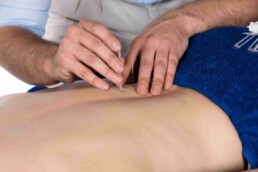If you’ve been experiencing chronic pain or tight muscles, intramuscular stimulation might offer relief. First, however, you might want to know a bit more about this technique, used by specially trained physiotherapists.
Origins
Intramuscular stimulation is actually a made-in-Canada solution to muscle tightness or pain. It was invented in the 1970s by Dr. Chan Gunn, a physician working for the BC Worker’s Compensation Board. Gunn was trained in Western medicine, but he was also adept at acupuncture, an ancient Chinese practice. He drew from both approaches to pain in creating IMS. It is based on the theory that much chronic pain results from the nerves overstimulating the muscles. IMS works to reset these nervous impulses as a way of reducing pain by using acupuncture needles to stimulate the affected muscles.
How Does IMS Work?
IMS releases or lengthens affected muscles so that they relax. Your IMS-certified practitioner will assess you to determine which, if any, muscles can be helped by this approach. They then sterilize the affected area and insert very fine needles – the same type of needles used for acupuncture – into a muscle and manipulate the depth and direction to stimulate healing. (The inserted needle targets a compressed nerve root.)
The needle causes the muscle to twitch or cramp in response, triggering a spinal cord reaction; once that occurs, the needle is removed. (If the muscle is functioning normally, it won’t twitch or cramp.) The muscle can then relax and begin to function normally. Dry needling, as it is called, also creates a tiny wound in the muscle that promotes blood flow to the area and stimulates healing by producing a healthy inflammatory response that removes toxins from the area.

How Does Intramuscular Stimulation Help?
Intramuscular Stimulation provides two major types of positive results: increased movement and significant pain reduction. As you progress through your treatment regimen, the tight bands of muscle will loosen and allow for increased joint mobility. In addition, as the muscle loosens, there will be less pressure and compression on your joints, nerves and ligaments, so your pain should subside.
Generally, depending on the duration of the pain, the tight or painful muscle will require a series of IMS treatments before the pain disappears or lessens to a great degree.
When Is IMS Appropriate?
IMS targets chronic musculoskeletal pain. It does not work for chronic inflammatory pain or other types of pain, such as pain from cancer, diabetes or degenerative neurological conditions such as Parkinson’s disease. IMS is usually not administered during pregnancy or to patients who have had surgery in the past 12 weeks. It has successfully been used to treat such issues as:
- Achilles Tendonitis
- Carpal Tunnel Syndrome
- Chronic postural pain
- Golfers and Tennis Elbow
- Chronic Tendonitis or Bursitis
- Headaches
- Iliotibial Band Syndrome Jaw and TMJ Pain
- Low Back Pain
- Myofascial Pain Syndrome
- Neck Pain
- Patello-femoral Syndrome
- Plantar Fasciitis
- Piriformis Syndrome
- Repetitive Strain Injuries
- Sciatica
- Shin Splints
- Shoulder and Hip impingement syndromes
- Spinal Disc Problems
- Torticollis Trigger Finger
Will IMS Be Painful?
IMS is generally considered to be unpleasant, but not painful – especially given the results. Each needle is only inserted for a few seconds, but as the muscle is stimulated into relaxation, there may be a bit of discomfort before the pain dissipates. Pain relief may happen quickly or it may take a few days. In addition, patients generally have increased movement and muscle function as a result. The IMS-trained physiotherapist carefully identifies the points for needle insertion so that the affected muscles can react.
Afterward, you may experience some bruising and soreness in the area. Your physiotherapist may recommend that you avoid vigorous exercise or stress to your body so the treatment can take effect. Drinking a lot of water and applying heat to the area will flush the body and assist in healing.
Acupuncture Compared to IMS
Acupuncture and IMS both use the same needles and dry needling technique, but they are very different therapies.
Acupuncture is an ancient Chinese medicine technique that focuses on using needles to stimulate the body’s meridians of energy, specifically those related to a certain organ or muscle. A series of needles is inserted around a particular point and may be left there for 10 to 20 minutes to effect change.
IMS, a technique that is only about 50 years old, blends Western medicine with traditional Eastern medicine to impact chronic pain and muscle dysfunction. It is based on Western medicine’s understanding of the human body’s physiology and anatomy.
Acupuncture is relaxing, but IMS can often be intense. However, both strive to help the patient feel better.
